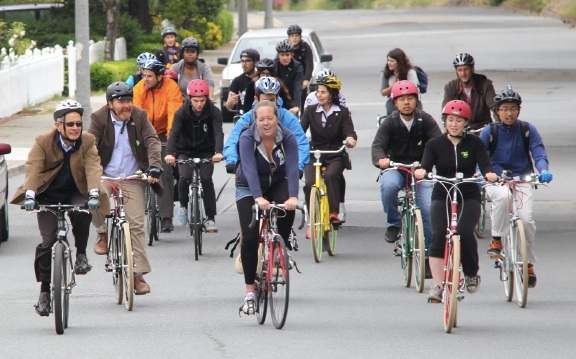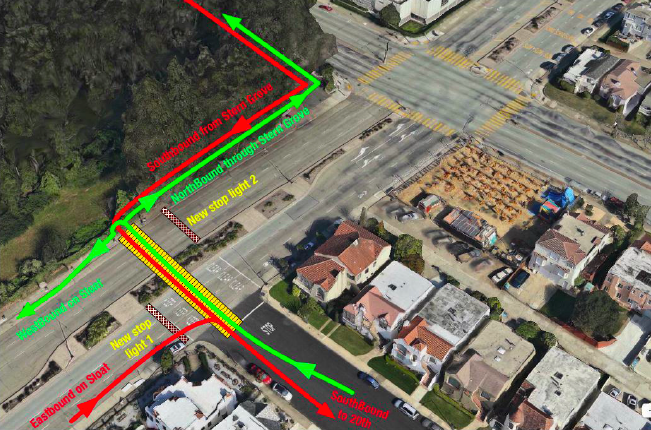Students Suggest Ways to Get Peers Biking to SF State University
5:19 PM PDT on September 29, 2014

Northern California is home to the two most bicycle-friendly universities in the entire country, according to the League of American Bicyclists -- and yet a mere 9.5 percent of students pedal to San Francisco State University, the Bay Area's second largest campus. The university's new Bicycle Geographies class sought to understand why so few students cycle to school, and published a report in May detailing the students' findings and recommendations.
“The intent was to use the campus as a living laboratory,” said professor Jason Henderson, author of Street Fight, who created the class so that students could help address the problem of access to the ever-growing university.
As part of an agreement with city agencies, SFSU is required to take measurable steps to minimize the transportation impacts of the growing student population, mainly by reducing drive-alone commutes. The Transportation Demand Management Plan of 2009 [PDF] showed that 33 percent of students drove alone at some point in their journey to campus -- more than the 27 percent of commuters citywide who drive.
Students began by collecting information on what barriers prevent students and faculty from biking to school. A survey conducted by the students found that, while 48 percent of respondents owned a bicycle, only 9.5 percent use their bike to get to campus. That's even though many survey respondents live less than three miles away.

About 60 percent of respondents said they came by transit: Students pack Muni's M-Ocean View and 28-19th Avenue lines despite their unreliability. The SF County Transportation Authority has studied speeding up the M by moving the light-rail line underneath busy 19th Avenue, and the SFMTA plans to speed up the 28 with transit bulb-outs and consolidated stops. But transit improvements may not suffice to seriously reduce driving to SF State.
“There’s got to be another way,” said Henderson. “Bike infrastructure is a practical and relatively inexpensive way to mitigate traffic impacts from [student population] expansion." But if millennials are so much more keen on biking than their parents, what keeps these 20-somethings from pedaling?
The survey found that 30 percent of respondents said that poor bike infrastructure and unsafe streets leading to the campus made bicycling unfeasible, and another 13 percent cited a lack of secure and convenient bike parking. "Those who did not cycle to campus wanted better bike infrastructure before they'd consider getting on their bikes," said Henry Pan, one of the students who helped conduct the survey.
Janice Li of the San Francisco Bicycle Coalition reiterated that bicyclists need to feel safe and comfortable on city streets. "As already identified by the city's bicycle network," she said, "we know where those streets are: Ocean Avenue, Holloway Avenue, Sloat Boulevard and beyond."
It's no wonder why so many of these would-be bicycle commuters feel intimidated by heavily-trafficked motorways like 19th Avenue and Sloat Boulevard, two state highways that cut the campus off on the north and east and largely lack any bicycle accommodations. Holloway to the east does have a bike lane in the few blocks closest to the campus, but Pan and others say there’s more work to be done to make it a comfortable bikeway. “I don’t feel any safer than before, when there were just sharrows there,” said Pan.
"Ultimately," said Li, "we need to see real corridor-length treatments, with specific attention given to the large, complex intersections along each of these streets, if we want to encourage students, faculty and staff, and families to walk or bike along this corridor." The SFBC has focused on improving connectivity and infrastructure along nearby Ocean Avenue, between Balboa Park Station and the SF State University campus.
To address the concerns that students raised, the report recommended new bikeways to make students' commutes safer, as well as providing more secure and convenient bike parking once they arrive on campus.
Students from the Bicycle Geographies class imagined how nearby streets might be improved to make them more comfortable for more novice riders. One such solution was to turn Holloway into a bicycle boulevard -- a slow-speed street that prioritizes bicycling through physical design measures that slow drivers and reduce cut-through car traffic, including signage, pavement markings, and traffic diverters. Examples of bike boulevards can be seen on Berkeley’s Channing and Russell Streets.

Another solution proposed by the Bicycle Geographies team was to modify the dangerous intersection of Sloat at 20th Avenue, to include a more direct, signalized crossing of Sloat, plus with a protected bike lane on 20th leading to the Stonestown Galleria parking lot and onto the campus.
Bike commuters can also face difficulties parking on the SF State campus. The university has a Bike Barn, a 200-space attended indoor bike parking facility, but even if students know about it, it's out of the way for many students rushing to class. Student analysis showed that the dreary and somewhat hidden structure suffers from inadequate funding, maintenance, and publicity. “Some people on our team didn’t know the Bike Barn existed until they took the class,” said Pan. Many of the bike racks around campus are tucked against buildings and behind walls, out of the view of the public, and not necessarily close to students' destinations.
Long Beach’s Bike Station was one model of a dignified and sociable bike parking facility cited by the students. Additionally, the team also recommended moving the Bike Barn to a more visible and accessible location, like near the corner of 19th and Holloway.
Students said they hope the report provides valuable insight for university's administration and its future, but they also found that it enlightened them about the possibilities of biking to school themselves.
Helen Keomany said working on the report encouraged her to start bicycling to campus. "I had only ridden a bike in SF three or four times before taking that class,” she said. "It was one of the most rewarding classes I've taken at SF State.”
Stay in touch
Sign up for our free newsletter



